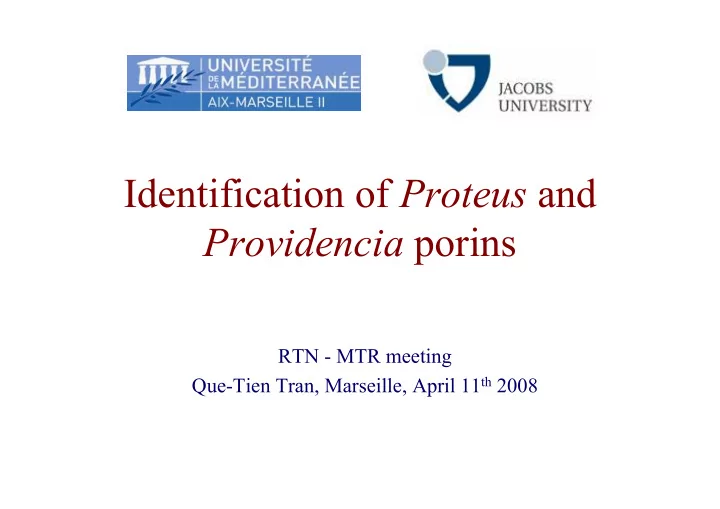

Identification�of ������� and ����������� porins RTN�� MTR�meeting Que�Tien Tran,�Marseille,�April 11 th 2008
Dealing with infectious diseases • Emergence�of nosocomial�infections • Decreasing antibiotic susceptibility among Gram�negative bacteria (GNB)�in�clinic – Multidrug resistant (MDR)� isolates frequently observed • Inefficacity of conventional antibacterial agents�� Intrinsic resistance • Requirement of new�alternative�efficacious molecules for� therapeutic • Full�understanding about�resistance mechanisms and their regulation is difficult but�urgently necessary
The bacterial outer membranes • First barrier of cell defense • Molecular filter for�hydrophilic molecules or�permeability barrier for�hydrophobic substances�(especially in�enteric bacteria). • Modification�of the permeability may concern several antibiotic classes� • Intrinsic resistance of bacteria
Porins • Pore�forming proteins in�outer membrane�of GNB,� mitochondria,�plastids • Uptake pathway of small molecules (≤600�Da)�including antibiotics:�β�lactams,�quinolones… • Modified porin expression�(decreasing or�mutation)�→ change� of membrane�permeability • Most�studied porins: ������� OmpF,�OmpC &�PhoE • Porins classification:� – General (OmpF,�OmpC ,�PhoE)�or�specific (LamB,�ScrY…) – Trimer�(OmpF,�OmpC,�PhoE)�or�monomer (OmpG…)
������� OmpF �������������� A)�Trimer viewed�from�the�top.�B)�Monomer�viewed�from�the�side.� C)�Residues�at�the�constriction�zone�of�the�monomer�viewed� from� the�top�(Cowan� ������ ,�1992)
Constriction�domain�of�OmpF porin
It�is�now�required�to�extend�our�expertise� concerning�the� �������� porins to�other�less� studied�Gram�negative�pathogens�that�cause� emerging�infectious�diseases�due�to�their� high�resistance�level.
������������ and ����������� ��� • GNB,� ������������������ ,�tribe� �������� ���������� ������������������������ • Straight�rods,�motile,�facultative�anaerobic • Environment,�gastrointestinal�flora • Opportunistic�pathogens,�urinary�tract�infection�(bladder� stone)�→ Risk�group�2�(lab�accessibility�in�Marseille) • Hospital�acquired�infection • They�are�closed in�term�of�DNA�relatedness�but�distant�from� �� ����
������������ and ����������� ��� ����������� ����������� ��� Species ������� �������� ����������� �������� ������������ ������������� �������������� ����������� �������������� ���������������� Antibiotic� Aminoglycosides,�quinolone,� Aminoglycosides, susceptibility� C3G�C4G,�carbapenem,� fluoroquinolone,�C3G,� azthreonam,�ticarcillin� carbapenem clavulanic acid,�trimethoprime� sulfamethoxazole Genomic ������������ by�Sanger�Institute not�yet annotation
����������� �������� • Cutaneous colonisation • Species�with�isolates�the�most�resistant�towards� antibiotics�of�the�family • Susceptibility�:�� C3G Carbapenem Aminoglycoside Fluoroquinolone • Antibiotic�resistance – Cephalosporinase (AmpC) – ESBL: TEM,�SHV,�CTX�M,�VEB… – Permeability:�LPS�modification Outer�membrane�proteins�?!
Susceptibility to�antibiotics by�minimal�inhibitory concentration (MIC�in�Ig/ml) IPM EPM MPM FEP CPO CAZ FOX CM SFX ����������� ATCC�29914 2 ≤0.06 ≤0.06 ≤0.06 ≤0.06 ≤0.06 2 32 ≤0.06 ����������� 19539 2 0.25 0.25 0.5 1 4 16 32 ND ����������� 65237 2 0.25 ≤0.06 128 64 256 32 256 128 ����������� NEA16 8�4 4 1�0.5 >256 >256 >512 64 256 32 ����������� 99645 4 1 1 >256 >256 >512 64 32 ND ����������� 2636 4 1 0,5 >256 >256 >512 64 512 128 ������������� ATCC�29906�(PR14) 2 ≤0.06 ≤0.06 0.25 0.25 0.25 4 32 ND ������������� 99594 2 ≤0.06 0.125 2 >2 >2 4 64 ND ����������� 5860 1 ≤0.06 ≤0.06 0.125 4 16 2 16 ND Abbreviations:�IPM�(imipenem),�EPM�(ertapenem),�MPM�(meropenem),�FEP�(cefepime),�CPO�(cefpirome),� CAZ�(ceftazidime),�FOX�(cefoxitin),�CM�(chloramphenicol)�,�SFX�(sparfloxacine),�ND�(not�determined).
Analysis of outer membrane�proteins 1.� ����������� ATCC�29914 2.� ����������� 65237 3.� ����������� 19539 4.� ����������� NEA16 5. ������������� ATCC�29906� 6.� ����������� 5860 Negative detection of the antigenic site�located inside porin which is reported as�loop 3�marker�of enterobacterial porins
�� ����� resistance selection with cefepime 1)� ����������� ATCC 29914�(no� antibiotic�treatment) 2)�FEP�0.06�Ig/ml 3)�FEP�0.09�Ig/ml� 4)�FEP�0.25�Ig/ml 5)�FEP�0.5�Ig/ml The�abbreviation�means�that� the�variant�was�selected�at�the� concentration�of�cefepime indicated.� Same response observed with cefoxitin
Resistance selection with imipenem 1)� ����������� ATCC 29914�(no� antibiotic�treatment),� 2)�IPM�1�Ig/ml, 3)�IPM�2�Ig/ml,� 4)�IPM�4�Ig/ml,� 5)�IPM�6�Ig/ml,� 6)�IPM�8�Ig/ml.� The�abbreviation�indicates�that�the� variants�were�selected�at�the� concentration�of�imipenem mentioned.�
Analysis of�outer membrane�proteins in�resistant variants • Several proteins involved in�response to�antibiotic by�losing or� decreasing the expression • Cefepime &�cefoxitin variants�present a�decrease of�production� of�immunorelated porins Resistance by�lowering cephalosporin uptake • No�resistant variant�selected with imipenem exhibit a� modification�of�immunorelated porins Porin expression�in�response to�imipenem is different than to� cephalosporins (at least with the concentrations�tested)
Comparison of�predicted a.a�sequences OmpPm &� OmpPv with OmpF,�OmpC,�PhoE
The internal loop 3�domain In� ������� ,�L3�loop length is well conserved with important� modification�of residues compared to� ������� general porins This�may explain the negative detection of the enterobacterial loop 3�marker�by�F4�antibody
������� porin • Semi�conservation of amino acid sequences compared to� ������� general porins • Conservation�of typical porin structure�with: 16�β�strands 8�periplasmic turns 8�extracellular loops • Several porin key residues conserved • Important�modification�in�the internal L3�loop
Discussion�on�OmpPm Special conformation�of the eyelet inside porin ?� Different functional and structural�organization of porin channel ?! Involvement in�antibiotic susceptibility ?�Role of L3� loop ?
What about� ����������� porin?
Southern blotting Probe:� ������� ��������� ����� Templates: genomic DNA Positive�controls:� ����� amplicon Hybridization t°:�50°C Different restrictases used,� Positively clear signal�obtained with HindIII
Southern blotting ������������ ����������� gDNA ����� gDNA EcoRI HindIII Fragment�about� 3.5�Kb
����������� porin amplification�by�PCR� 1�������2���������������������3��4���5��6����������������7
PCR�for� ����������� porin amplification� 1���������2���������3��������4��������5���������6����������7 The products were cloned into pGem�T�easy vector for�sequencing
����������� porin sequence compared to� ������� homolog ��� ������� �������� �� ����������������� �������� ��� ���������� ��� ���� ������
Recommend
More recommend